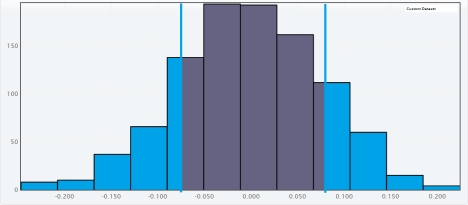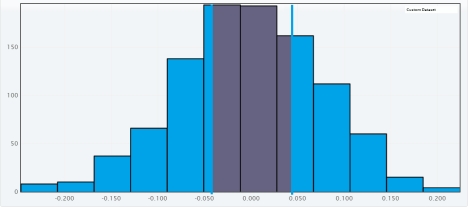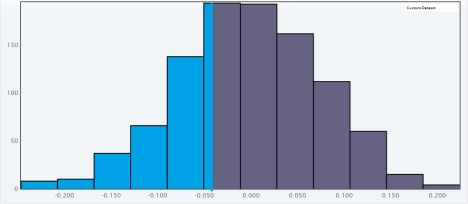Multiple Choice
An article describes the results of an experiment. Patients suffering from chronic somatic diseases were randomly assigned to the two groups. One group was a control group of patients who received treatment A. Of the 58 patients in this group, 9 reported improvements at the end of the study period. Patients in the second group received treatment B. Of the 33 patients in this group, 4 reported improvements at the end of the study period.
Do these data provide evidence that the proportion of success for patients who received treatment A differs from the proportion of success for patients who received treatment B? Use a randomization test to select the appropriate output for one set of 1000 simulated proportions and carry out a hypothesis test for a difference in proportions. Use a significance level of 0.05.
A) 
 The approximate
The approximate  -value is 0.316.Since it is lower than
-value is 0.316.Since it is lower than  , we reject
, we reject  for a significance level of 0.05 .There is significant difference between the proportion of success for patients who received treatment A and the proportion of success for patients who received treatment B.
for a significance level of 0.05 .There is significant difference between the proportion of success for patients who received treatment A and the proportion of success for patients who received treatment B.
B) 
 The approximate
The approximate  -value is 0.655.Since it is greater than
-value is 0.655.Since it is greater than  , we fail to reject
, we fail to reject  for a significance level of 0.05.There is not convincing evidence that there is difference between the proportion of success for patients who received treatment A and the proportion of success for patients who received treatment B.
for a significance level of 0.05.There is not convincing evidence that there is difference between the proportion of success for patients who received treatment A and the proportion of success for patients who received treatment B.
C) 

The approximate  -value is 0.345.Since it is greater than
-value is 0.345.Since it is greater than  , we reject
, we reject  for a significance level of 0.05.There is significant difference between the proportion of success fot patients who received treatment A and the proportion of success for patients who received treatment B.
for a significance level of 0.05.There is significant difference between the proportion of success fot patients who received treatment A and the proportion of success for patients who received treatment B.
D) 

The approximate  -value is 0.034.Since it is lower than
-value is 0.034.Since it is lower than  , we reject
, we reject  for a significance level of 0.05.There is significant difference between the proportion of success for patients who received treatment A and the proportion of success for patients who received treatment B.
for a significance level of 0.05.There is significant difference between the proportion of success for patients who received treatment A and the proportion of success for patients who received treatment B.
E) 

The approximate  -value is 0.966.Since it is greater than
-value is 0.966.Since it is greater than  , we reject for a significance level of 0.05 .There is not convincing evidence that there is difference between the proportion of success for patients who received treatment A and the proportion of success for patients who received treatment B.
, we reject for a significance level of 0.05 .There is not convincing evidence that there is difference between the proportion of success for patients who received treatment A and the proportion of success for patients who received treatment B.
Correct Answer:

Verified
Correct Answer:
Verified
Q1: Two samples are said to be independent
Q32: A hotel chain is interested in evaluating
Q33: When constructing a confidence interval for the
Q34: When testing hypotheses concerning differences in treatment
Q35: A marketing strategist would like to determine
Q36: A group of people received the same
Q37: In many animal societies, a role assumed
Q38: In many animal societies, a role assumed
Q39: A researcher would like to learn about
Q40: For which of the following sample sizes